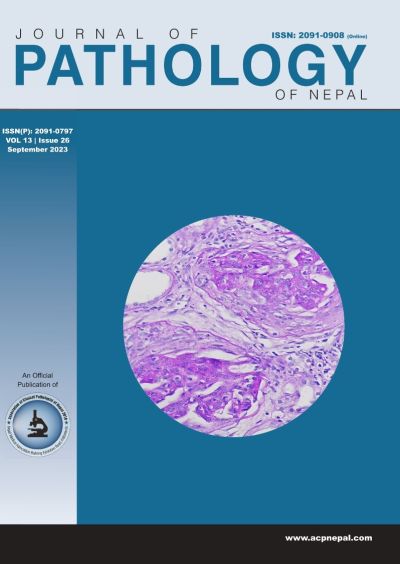Role of topoisomerase II α and Ki -67 biomarkers in pituitary tumors
DOI:
https://doi.org/10.3126/jpn.v13i2.51016Keywords:
Immunohistochemistry, Ki67, Pituitary adenoma, Prognosis, Topoisomerase IIαAbstract
Background: Pituitary Adenoma, a neoplastic proliferation of anterior pituitary hormone producing cells, is mainly considered benign but some are clinically aggressive and recurrent and very rarely malignant. From recent advances in pathological and molecular study, there is a continuous search for numerous prognostic biomarkers, to analyze better tumor behavior and prediction of response to treatment and recurrences. This study was conducted to see the epidemiological spectrum of pituitary tumors and to evaluate the correlation of TOPOISOMERASE IIα (Topo 2A), and Ki-67 biomarker with recurrence, aggressiveness, hormone subtype, radiological invasiveness, and prognostic grade of pituitary tumors.
Materials and methods:This was a prospective study with a total of 54 cases. We studied the clinical behavior, radiology, histopathological findings, and immunohistochemistry with Ki-67, Topoisomerase IIα, over 3 years at a tertiary care center.
Results:When comparing Ki-67 expression with aggressiveness, a high degree of statistical significance was found (Mann -Whitney U Test, p-value <0.001 ). All of our aggressive tumors (8/54) had a Ki-67 level of≥3% while most of the nonaggressive tumors (46/54) had a Ki-67 level of <3%. When comparing Topo 2A expression with recurrence, a high degree of statistical significance was found (Mann Whitney U test, P value <0.001). Most of the recurrent tumor (11/15) had Topo 2A index of 1 % or more.
Conclusions: The benign, aggressive, recurrence, or malignant nature of PA can be effectively predicted with the help of immunohistochemistry such as TOPO 2A and Ki67, thereby guiding better patient management.
Downloads
Downloads
Published
How to Cite
Issue
Section
License
Copyright (c) 2023 The Author(s)

This work is licensed under a Creative Commons Attribution 4.0 International License.
This license enables reusers to distribute, remix, adapt, and build upon the material in any medium or format, so long as attribution is given to the creator. The license allows for commercial use.




